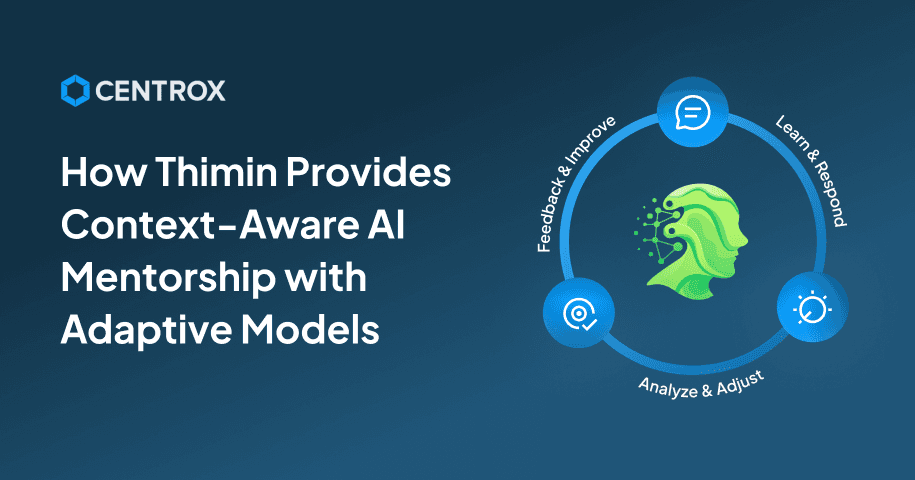How Thimin Provides Context-Aware AI Mentorship with Adaptive Models
Discover how Thimin delivers Context-Aware AI Mentorship by exploring its approach, process, and challenges for better life coaching.
8/29/2025
artificial intelligence
8 mins

Recently, we have been observing increasing numbers of reported cases of stress, anxiety, and depression. These growing numbers are alarming for the future, raising the need for reliable support whenever needed. Here AI AI-powered context-aware mentorship can prove to be an instant mentor that is always available to hear you out.
An AI-driven mentor like Thimin enables a handy tool that extends context-aware mentorship whenever and wherever you need this. Its AI algorithm makes a realistic, emotionally intelligent conversation, which resembles how humans interact. This humanized way of making AI driving conversation helps in creating a comfortable space for users, where they can openly express their thoughts.
Through our article, we will take you through the research and technology that powers this Thimin solution, and make you aware of the challenges that were encountered, along with informing you about its key application and what future potential this holds.
How Thimin Impacts Life Coaching for Personal Growth?
These days, when the world is evolving every minute, we are witnessing growing competition in every sphere. The constant pressure to be on top sometimes contributes to shattering confidence, making you feel unworthy and incompetent, and ultimately leads to stress, anxiety, and depression.
For today's busy lifestyle, where everyone is running short on time, finding a life coach who can listen to you and guide you in the right direction is very difficult. Thimin comes as a reliable AI-mentor who listens to your doubts, confusion, and apprehensions, helps you navigate them, and facilitates you in finding your lost motivation.
Research Behind AI Mentorship
Ensuring reliable AI mentorship is indeed a critical requirement, as it has a direct impact on personal well-being. Therefore, for making an AI life coach like Thimin, to ensure the best user experience, we found out a few important parameters that needed thoughtful consideration. Below, we have mentioned parameters that helped us in developing an AI solution that addresses users' life coaching needs:

1. Latency & Turn-Taking Thresholds
Research has highlighted that humans perceive delays over 200–300ms as disruptive in conversation. Therefore, every stage of the pipeline must be optimized for low-latency streaming rather than using batch mode. ( Heldnar et al., 2010)
2. Robust Voice Activity Detection (VAD) Under Noise
Studies have shown that noisy environments tend to drastically degrade both ASR accuracy and interaction quality. So it's very critical to use advanced voice activity detection to reliably detect when a user is actually speaking.(Dengshi Li et al., 2023)
3. Context Retention & Dialogue State Tracking
Research in dialogue systems (DSTC benchmarks, Henderson et al., 2014) brought the importance of tracking context across turns to notice. This emphasized that the pipeline should not just transcribe responses but also maintain a structured dialogue state (e.g., goals, reminders, open queries) so the LLM doesn’t “forget” user intentions and needs mid-conversation. (Henderson et al., 2014)
4. Privacy & Ethical Safeguards
Studies have also stressed the risks of PII leakage and voice data misuse. Therefore, it's important to ensure that its implementation includes TLS encryption, retention limits, redaction policies, and user consent mechanisms from day one. ( Aloufi et al., 2020)
How Thimin Delivers Context-Aware AI Mentorship?
With our approach, we have worked to provide a solution that addresses research-based concerns and meets users' expectations of an AI-driven mentor. Below, we have explained our methodology that works behind the scenes to ensure users with reliable, contextually accurate AI life coaching:

1. WebSocket Session
The pipeline for thimin begins with a persistent WebSocket (wss://) channel, which is optimized for low-latency, full-duplex communication. Then the Audio packets, STT outputs, and TTS frames flow with session IDs, sequence numbers, and timestamps to ensure the right ordering. Through its reliable streaming protocol, it ensures that it remains responsive at the threshold of human conversational perception.
2. Audio Capture & VAD
Then the raw microphone input undergoes digital signal processing like noise suppression, acoustic echo cancellation, and gain normalization. With its Voice Activity Detection (VAD) model, it segments frames into voiced versus silent regions. This VAD works as a gatekeeper that helps in reducing wasted compute while ensuring chunking speech into meaningful segments.
3. Streaming STT
The received audio is then streamed into an ASR model that emits subword tokens (WordPiece/BPE) with confidence scores. The partial transcripts are provided in near real time and finalized at utterance completion. This approach provides early token emission collapses latency, enabling AI to keep pace with natural human speech.
4. LLM Processing
Additionally, STT output is passed through a streaming Transformer LLM that generates tokens autoregressively while holding context windows for dialogue continuity. The LLM not only works to generate responses, but it also thinks, remembers, reasons, and executes.
5. Streaming TTS
Then the completed sentences are streamed to a neural TTS stack. With its context-aware responses, it generates speech that mimics a human, collaborative, and empathetic tone.
6. Goal & Reminder Handling
When the intent of the user is recognized, the system performs slot-filling (time, recurrence, description) before persisting tasks into a Postgres + Redis scheduler. The confirmation is formalized via TTS. This grounds actions in a dialogue state, as suggested in task-oriented dialogue research, so that the reminders remain durable across sessions rather than transient chat artifacts. By doing this, it converts the conversational AI into a true utility layer that augments daily workflows.
7. Metrics & Privacy
To ensure privacy for conversations, the system continuously measures WER (ASR accuracy), token latency (LLM responsiveness), and RTF (TTS efficiency). All communication is TLS-encrypted, with PII redaction and retention limits applied to logs. This contributes to ensuring strong privacy guardrails, building trust at scale.
Challenges for Thimin ( AI Growth Mentor)
Building a real-time AI mentor demanded solving complex latency, synchronization, and interaction challenges. Each hurdle, from speech timing to streaming, required technical innovations to ensure natural, seamless human–AI conversations.
1. TTS Latency
Early text-to-speech models introduced noticeable delays in audio playback, disrupting conversational flow. Switching to faster, optimized TTS models drastically reduced latency, making responses feel instant and human-like.
2. Lip-Sync Accuracy
Generating natural facial movements aligned with audio proved difficult, as lip-syncing often felt robotic. Using Azure’s system enabled accurate mapping between phonemes and mouth shapes, resulting in more realistic face animations.
3. End-of-Speech Detection
Determining when the user finished speaking was challenging, often causing the AI to interrupt or wait too long. An end-of-speech detection model helped accurately segment turns, ensuring smooth conversational flow.
4. Real-Time Streaming
Maintaining uninterrupted, continuous interaction required stable streaming. Implementing WebSockets allowed bi-directional, low-latency communication, enabling dynamic response updates and fluid real-time dialogue without conversational breaks.
Applications of AI Mentorship
Thimin extends a real-time context-aware mentor by combining STT, LLM, reasoning, and TTTS for natural voice-driven conversation. This helps in keeping track of conversation goals, adapting to intent, and making conversation that ensures guidance. Eventually, it boosts morale, skill building, productivity, and personal growth for academic, professional, and personal life issues.

1. Personalized Skill Coaching
The AI mentor can help in encouraging and guiding you for real scenarios like public speaking, language learning, or interview preparation. With its low-latency STT and LLMs, it tends to analyze the phrasing and tone to offer guidance right away.
2. Cognitive Behavioral Support (Mental Health Aid)
AI mentor like this can be used for intent identification and dialogue tracking, through which it can motivate users with structured exercises for self-reflection, detect negative thinking patterns, and keep reminding them about coping strategies that will help them reach their goals. Acts as a 24/7 low-cost companion for mental well-being, reducing dependency on overburdened human counselors.
3. Executive Productivity Assistant
For extremely busy professionals, it comes as a handy tool that can schedule tasks, set reminders, and motivate users toward their long-term goals through conversational goal management. Unlike static to-do apps, it adapts dynamically to user intent and changing priorities in real-time conversations.
4. Continuous Learning Mentor for Professionals
By integrating with knowledge bases or learning platforms, this AI mentor can assist you by becoming your personalized tutor, explaining complex topics and ideas in digestible steps, quizzing users, and tracking progress over time.
Future of AI Mentorship
AI mentorship introduces an evolution in human–machine interaction, through low-latency STT, streaming LLMs, and neural TTS converge into a continuous, adaptive feedback loop. Thimin is an example of how advances in dialogue state tracking and intent recognition transform mentorship from episodic to persistent, context-aware engagement.
This is not just about task execution; it is semantic grounding in real time, where supportive guidance evolves simultaneously as users do. But the frontier lies in scaling such architectures responsibly: optimizing inference pipelines, ensuring privacy, and preserving conversational fluidity.
As these AI-powered pipelines mature, AI mentors will definitely redefine accessibility to expertise, embedding continuous learning, productivity, and personal growth into daily life, quietly shaping the fabric of how humans advance alongside intelligent systems.
The open question remains what emergent capabilities arise when mentorship itself is modeled as an always-on system architecture? Discuss with our experts at Centrox AI, and let's explore futuristic possibilities together.

Muhammad Harris
Muhammad Harris, CTO of Centrox AI, is a visionary leader in AI and ML with 25+ impactful solutions across health, finance, computer vision, and more. Committed to ethical and safe AI, he drives innovation by optimizing technologies for quality.
Do you have an AI idea? Let's Discover the Possibilities Together. From Idea to Innovation; Bring Your AI solution to Life with Us!
Your AI Dream, Our Mission
Partner with Us to Bridge the Gap Between Innovation and Reality.
